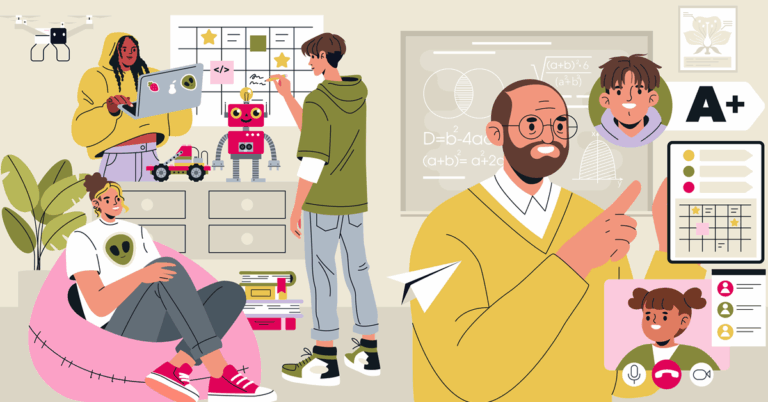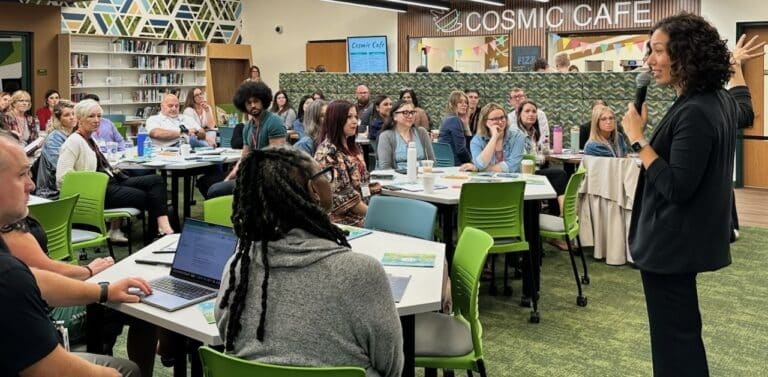By Kayla Towner, originally published in Utah’s Digital Teaching and Learning newsletter
The moment I moved from being a second-grade teacher to a fifth-grade teacher, I fell in love with the power of technology in the classroom.
After completing a professional development opportunity with Microsoft Education, I jumped in with both feet to utilize the brand-new Microsoft OneNote Class Notebook and Microsoft Classroom (now called Teams). My students were so excited to use the latest technology to capture their learning in their online notebooks and voice record their thoughts. They learned the concept of volume in creating 3-D figures in Minecraft Education. I felt confident I was preparing them for their future.
However, my students drowned in the intoxicating fumes of technology, and many of them did not fully learn the content. I failed my students. As time went by, I learned different teaching models that had a technology emphasis. I was able to revamp my craft. I realized that content and pedagogy are the front runners in education and that technology needed to be the enhancer. To transform my classroom and really prepare students for graduation, I needed to take these tools and implement them in a new way.
I believe Utah’s Portrait of a Graduate and Personalized, Competency-Based Learning initiative is the new innovation and needs to be focused on and implemented in K-12 schools. Utah’s Portrait of a Graduate describes ideal attributes of a Utah graduate. Characteristics such as mastery, autonomy and purpose start at home and are refined in educational settings. The Utah Portrait of a Graduate requires a shift in both outcomes and how we approach education for K-12 students.
Learn about the educator collaboration and goals behind Utah’s alignment of competencies and their Portrait of a Graduate.
Learn more >>
Though Utah’s Portrait of Graduate provided insight prior to the pandemic, I embraced the ideology in order to help my students’ learning once the schoolhouse expanded to their personal homes in March 2020. Before COVID-19, I attended a personalized, competency-based learning conference and learned the importance of student autonomy and student choice. I was mesmerized and overwhelmed by this new model, but I could see the value in it for my students. I started small and implemented these concepts in my own classroom. I created interactive resources like hyperdocs, personalized playlists and choice boards. These resources provided opportunities for my students to develop their understanding in different ways and transfer the ownership of the learning from me to each student.
During the height of COVID-19, my classroom became a true blended learning model that was focused on personalized, competency-based learning and Utah’s Portrait of Graduate. My students followed the station rotation model of individual rotation. I implemented the individual rotation model by providing students specific stations they could complete to achieve the learning targets. This blended model focused on students showing competency for any given standard. I was allowing them choice, time and pace, with goals aligned to the Portrait of Graduate. My students were getting autonomy in how they learned the content.
For example, I created a choice board that focused on reading, listening and writing. Students had Monday through Friday to complete at least two activities in each focus area. Within this choice board they could choose to read their own book, they could read curated online resources such as Newsela, Wonderopolis, Sora, Epic, etc., or they could read on our online reading website, Raz-Kids. For the first time, they were able to demonstrate mastery on a standard or objective where they got choice. I learned early on with technology, I needed to become the enhancer of the learning that was being driven by my students.
Technology enables learning – but it isn’t central to the design of how we meet students’ needs. Learn how we can use technology to humanize learning.
Read now >>
This model also allowed for students to have a purpose. Utah’s PCBL Framework identifies “student agency” as a core element for success and explains that we need to empower students to take ownership of their learning with adaptable supports to amplify student growth and competence. Therefore, I had my students choose and keep track of their learning with our weekly goal trackers. The goals varied to reflect the needs of each student.
For example, some students made it their goal to turn in all their assignments for the week. Others made it their goal to use a positive mindset when confronted by challenges. Every day students would reflect on their learning and their goals and identify challenges and ways to improve. In this new approach, my students were in control of their learning and demonstrated improvement in growth and confidence. I truly believe that all teachers, schools, and districts need to embrace a personalized, competency-based learning model. The “personalized” element in the framework supports teachers in making the model their own; it’s not one-size-fits-all. Adapt it, remix it and play around with it.
I can see future classrooms where students take the driver’s seat in their learning experiences. Students are motivated to make their own decisions in their learning experiences. They get to choose how they will design and apply knowledge, and how they will demonstrate their learning. As more teachers adopt personalized, competency-based learning, we will create empowered lifelong learners who take ownership of their learning.
This South Carolina district works to ensure each student gets what they need to achieve at the highest levels. See how educators are transforming their classrooms from instructor-centered cultures to learner-centered cultures.

Kayla Towner is a technology trainer/instructor for Utah Education Network (UEN) and a Utah Hope Street Fellow in Salt Lake City, Utah.





